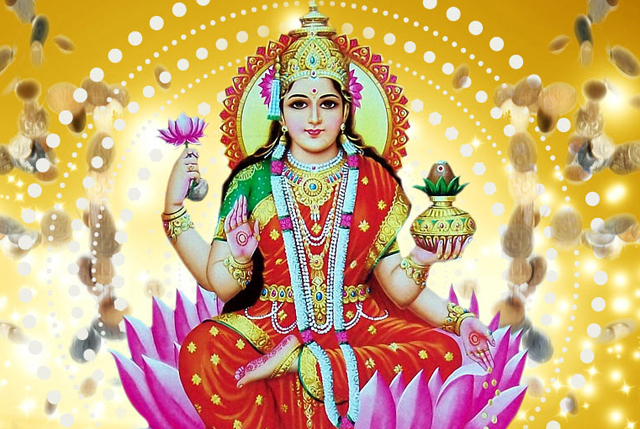Divali, meaning the Festival of Lights, is celebrated across the world with joy, warmth and hope. At the heart of this festival is the worship of Lakshmi Maa, who is often referred to as the Goddess of wealth and prosperity, but Her significance goes far beyond material riches. Lakshmi Maa is often revered in her form as Siddhi Lakshmi, the Bringer of Success and Fulfilment, embodying Gyaan Shakti (the power of wisdom). Lakshmi Devi is the divine source of abundance, but true prosperity comes in more than one form, each with spiritual and material dimensions.
The Eight Aspects of Lakshmi – Ashta Lakshmi
In Hindu tradition, there are eight forms of Lakshmi, collectively known as Ashta Lakshmi, which reflect different kinds of material wealth:
- Aadi Lakshmi: The primeval form of the goddess, who bestows happiness and well-being, not just in physical comforts but in a deep, fulfilling sense.
- Dhana Lakshmi: While Dhana Lakshmi represents wealth in the form of money or gold, it also encompasses inner strength, willpower, talent, virtues and good character.
- Dhanya Lakshmi: The goddess of food and nourishment, ensuring sustenance for the body and soul.
- Gaja Lakshmi: The bestower and protector of prosperity, grace, abundance and royal power.
- Santana Lakshmi: The wealth of good offspring, granting good health and long life to children.
- Veera Lakshmi: The bestower of courage, strength and power.
- Vidya Lakshmi: The giver of knowledge, of arts and sciences that uplift society.
- Vijaya Lakshmi: The goddess of victory in all spheres of life, ensuring success in all endeavours.
Each form reflects material wealth, but also contains a spiritual dimension. For example, Dhana Lakshmi teaches that wealth isn’t only monetary; it includes virtues that enrich one’s character. Vidya Lakshmi reminds us that true knowledge, especially when applied to the arts and sciences, is a lasting treasure. While material success is necessary to fulfil our needs and responsibilities, we must always remember that these worldly gains are fleeting.
Beyond Materialism: Lakshmi Maa’s Spiritual Wealth
Divali is essentially about recognising and cultivating the six forms of spiritual wealth, represented by Lakshmi Maa, which include:
- Tranquillity of mind
- Serenity
- Control of the senses
- Endurance
- Faith
- Renunciation of selfish desires
These qualities foster internal peace and fulfilment, which no amount of money or power can buy. In today’s world, marked by wars, greed and societal decay, these spiritual treasures are more essential than ever. Material wealth, symbolised by the colour red, is important for survival and comfort. However, it is spirituality, symbolised by white, that brings contentment. Lakshmi Maa is often portrayed in pink, a blend of red and white, signifying the balance we must strive for between the material and the spiritual.
Lakshmi Maa and the Origins of Divali
According to the Devi Bhagavata Purana, the origin of Divali is tied to the churning of the ocean of milk, from which Lakshmi Maa emerged. This signifies the appearance of prosperity after great effort and hardship, an eternal lesson in perseverance. Another story links Divali to the return of Lord Rama, Sita Maa and Lakshmanji to Ayodhya after their victory over Ravana, a great celebration marked by lighting rows of deeyas. However, it is important to note that this event occurred in the months of April-May, and not during the month of Kaartik (October-November), when Divali is celebrated. While the lighting of deeyas was part of the joyous occasion, it is not linked to Divali.
The Metaphysical Significance of Divali Rituals
On Divali day, we perform puja, light deeyas, decorate our homes and offer tasty meals to welcome Lakshmi Maa into our lives. However, these rituals have a deep, metaphysical meaning. The lighting of six deeyas corresponds to the awakening of the six chakras in the human body, from the base of the spine to the forehead, which then culminates in the enlightening of the crown chakra, the thousand-petalled lotus at the top of the head. The spine, which connects these energy centres, represents the mountain of mental and spiritual advancement, and there are rivers and streams of some 72,000 naadis—the energy channels in our body.
Activating these energy centres is the true internal application of Divali. By awakening our chakras, we energise not just our bodies but also our minds and spirits. The problems we face in life, from lack to unhappiness, often stem from an absence of spirituality. Divali reminds us to think beyond the social and material aspects of the celebration and embrace its spiritual core.
By awakening our chakras and our spiritual potential, we can navigate life’s challenges with grace and strength, fulfilling our divine purpose in this world.
Wishing everyone a spiritually fulfilling Divali.



